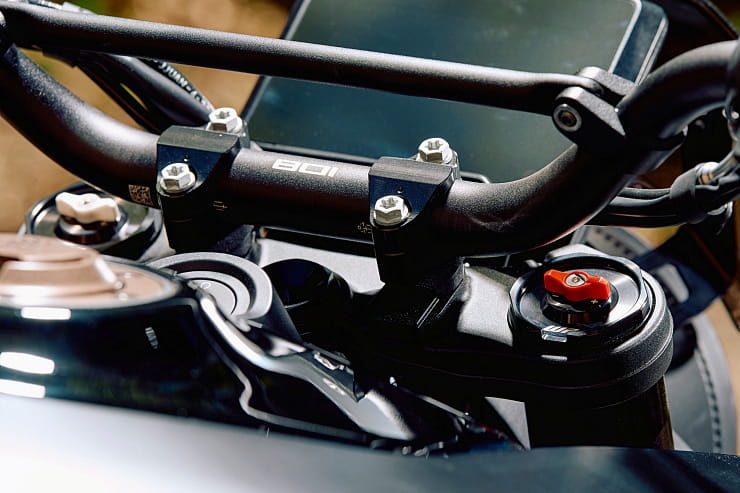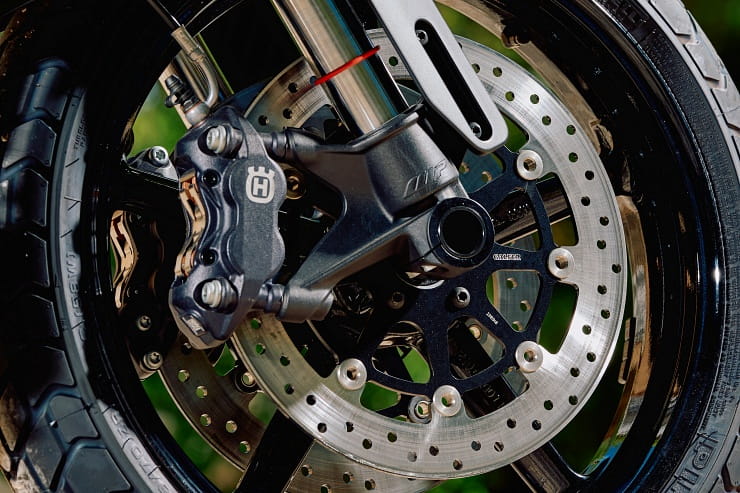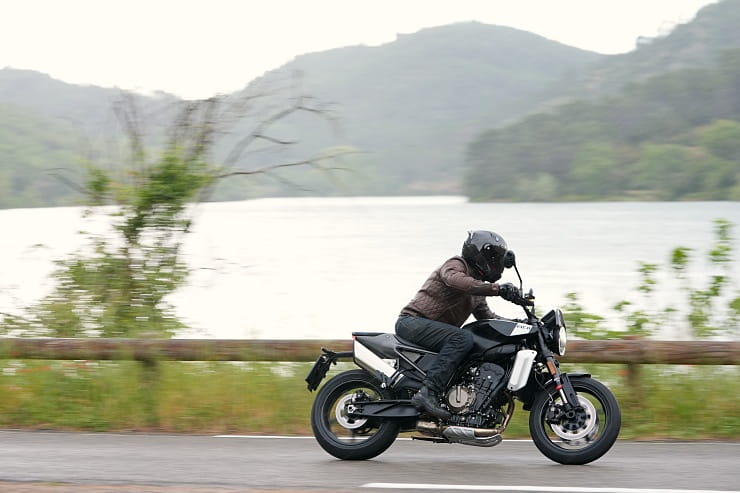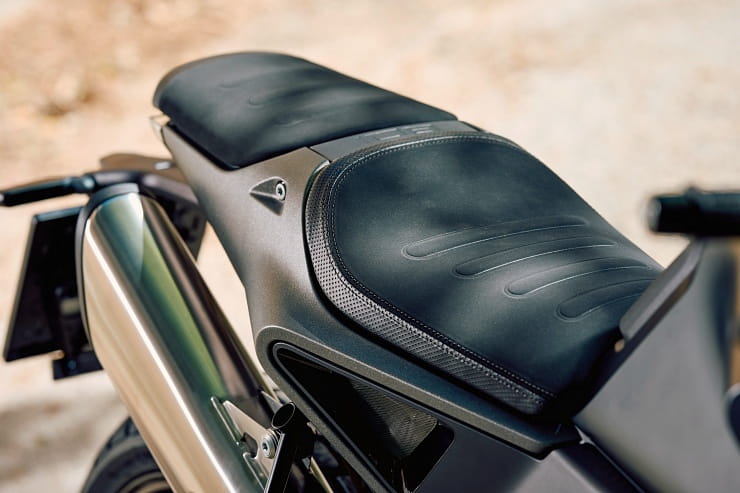Technical Review: Ben Purvis
Press launch review: Martin Fitz-Gibbons
Price: £10,499 | Power: 103bhp | Weight: 191kg | Overall BikeSocial Rating: 4/5
Remarkably, Husqvarna’s scrambler-styled Svartpilen range is almost 10 years old, having first been revealed as a concept back in 2014. Ever since then, the model has stayed strictly single, from the original 401, to the flagship 701 and the more recent learner-legal 125. Now, for the very first time, a Svartpilen is available with a twin-cylinder engine.
This new 801 replaces the discontinued 701 but broadly follows the same Svartpilen formula: distinctive modern/retro styling, built around the mechanical foundations from a KTM Duke. In this case, it’s the 790 Duke – a bike that’s now, slightly confusingly, actually built by CFMoto. So what do we really have here then? Is this simply a rebadged version of an already-rebadged bike? Or is the Svartpilen 801 really unique enough to deserve a spot among the increasingly crowded world of parallel-twin roadsters? BikeSocial flew to the world launch in the south of France to find out…
Pros & Cons
- Higher tech, suspension and engine spec than the 790 Duke it’s based on.
- Distinctive Svartpilen styling neatly dovetails both retro and modern.
- Appeal is much more than just superficial – it’s a capable and versatile roadster.
- Definitely not cheap, with an awful lot of other superb nakeds for the money.
- Changing up through the gearbox can feel stiff and reluctant.
- Clue’s in the name, but it only comes in black.
Review – In Detail
Price & PCP
Engine & Performance
Handling & Suspension (inc. weight & brakes)
Comfort & Economy
Equipment
Rivals
Verdict
Specification
The Svartpilen 801 costs £10,499 in the UK. That’s a hefty chunk of change, and a whopping £2500 more than a KTM 790 Duke with which it will, naturally, be closely compared. What might account for that extra cost? For one, the 790 is so affordable in part because it’s built by CFMoto in China, where manufacturing costs are far cheaper, whereas the Svartpilen is assembled in Austria. In addition, the 801’s standard spec is slightly higher than the 790, particularly when it comes to suspension and electronics (more on both later).
There is some good news for early adopters, however. Husqvarna UK will be offering some incredibly low-rate finance deals, at least for the first few weeks, when the 801 lands in dealers this June. If you want to pick up a Svartpilen 801 on a three-year PCP finance, you’d be looking at a deposit of £2132.75 (a shade over 20%), followed by 36 monthly payments of just £89. If you want to keep the bike at the end, the optional final payment is £5567.50. That’s based on riding 4000 miles per year, with interest working out to an impressively low 1.9% APR.
The Svartpilen uses the 799cc parallel twin we first met in KTM’s 790 Duke back in 2017. That means four-valve heads, water-cooling, twin cams and twin balance shafts (one by the crank, one in the head). It keeps the 285° crankshaft too, for the same sound, feel and firing intervals as a 75° V-twin.
Two things to bear in mind here. First, the motor isn’t actually made by KTM any more – instead it’s made by CFMoto in China, then shipped as a complete unit to Austria, where the rest of the Svartpilen is assembled. That’s not necessarily a bad thing – we’re just reporting facts, not passing judgement.
Second, the Svartpilen’s power output is higher than the 790 Duke we get in the UK. Where the Duke makes 94bhp, the Svartpilen has 103bhp. That’s not down to any special treatment the Husky has had, but simply that the UK-spec Duke is A2-restrictable, where the Svartpilen isn’t. In markets where European licensing rules don’t apply, the 790 Duke normally makes 103bhp as well.
Otherwise, it’s pretty much the same engine. Gearing is identical, from primary to gearbox ratios to final drive sprockets. Valve sizes and throttle body diameters are unchanged too. One difference is that this motor now meets the latest Euro 5+ emissions standard – where the 790 Duke is only Euro 5.
But in use, that’s had no negative impact at all. It’s a fantastic engine – smooth, grunty and predictable at lower revs and through the midrange, but with a fizzing, fun-filled top-end as the revs surge to the 10,000rpm-ish limiter. Fuelling and throttle response are sublime in all of the three standard riding modes (Rain, Street and Sport), as well as the optional fourth (Dynamic). There truly isn’t the merest hint of any snatchiness in Dynamic mode, which almost makes you wonder if there’s really any use for Street or Sport.
There’s no unpleasant vibration either, those balance shafts working together to cancel any and all lumpiness. And it’s a generous, flexible motor, with a strong, flat torque delivery low down. The delivery is linear through to about 6500rpm or so, then it picks up in eagerness to give peak torque at 8000rpm, and peak power at 9250rpm. You can potter around town and it’s well-mannered and polite, or you can ride around in the smooth, purposeful midrange, or just scream it to its limiter. You realise that while the bike that donated this engine might have a reputation for brash, lairy lunacy, when the motor is removed from the fluro orange fanciness, there’s more to it than single-minded silliness: it’s actually really usable and versatile too.
The only downside is the gearbox, which can feel a bit stiff and stubborn especially when it comes to upshifts. There is a two-way quickshifter fitted as standard (an optional extra on the 790 Duke), and it works pretty well on downshifts, but it’s not quite so creamy smooth going up through the box.
The Svartpilen might look like it features a healthy dose of dirt-bike heritage, but to ride it’s a pure roadster. There’s no see-sawing back and forth on gangly, long-legged suspension; no awkward tip into turns on weird-sized wheels. Instead the 801 is light, agile, accurate and enormous fun to chuck about on the tight, twisty mountain roads at the bike’s world launch.
The chassis starts with a tubular steel main frame which looks, to our untrained eyes, identical to a 790 Duke’s. Husqvarna’s engineers say it’s not exactly the same item, however, and you couldn’t just swap frames between the two bikes. There is a difference in headstock angle, the Svartpilen having half a degree more rake (24.5° vs the 790’s 24°) which, in theory, should slow the steering down a whisker.
At the back of the bike is an open-lattice swingarm (cough, same as the 790’s, cough). Above it, the tail of the bike is actually the bolt-on rear subframe – two large castings which bolt together, meaning there’s no plastic panels to be found anywhere from seat to tail-light. It’s a neat bit of design, the kind of unique touch you’d proudly point out to curious onlookers. It’s functional too, housing the airbox – hence the mesh-covered air intakes on both sides immediately below the rider’s seat.
It's also perhaps responsible for the Svartpilen carrying a couple more kilos than the Duke. The 801 has a kerb weight of 191kg, four more than the 790. It’s not a huge difference, and the end result it still pretty light for an 800cc naked. And that’s how it feels to ride – slim, sprightly and nimble on its flat-track-style Pirelli MT 60 RS tyres.
Wheels are cast (we’re told wire-spoked wheels are in development, but not ready yet), and in standard 17-inch sizes. Brakes are made by J.Juan but feature Husqvarna logos. The four-pot radial front calipers are a little gentle on initial bite, but there’s no shortage of power given a decent squeeze. They’re backed up by cornering ABS, which also offers a ‘Supermoto’ setting which lets you lock up the rear wheel.
Suspension is by WP – naturally, given it’s a Pierer Mobility Group bike – with 43mm forks up front, and a linkage-free shock lying almost flat under the rider’s seat. Both ends offer a decent amount of adjustability. The forks have split damping (rebound in the right leg, compression in the left leg), set by oh-so-simple five-step clickers on the fork tops. The shock offers preload adjustment via a stepped collar, and a dial for rebound damping at the bottom of the shock body. The overall setup is on the softer side, like ride comfort has been given the nod over chassis sportiness, while the damping generally feels pretty high quality. The one exception is when it comes to tackling bumpier roads at speed, where the shock can sometimes feel like it’s plunging and leaping up and down through its stroke a little too eagerly. Perhaps making use of that damping adjuster would have improved things – truth be told, it was such a minor and infrequent observation that it didn’t even seem worth stopping to look for a screwdriver.
The Svartpilen’s saddle might look like a short, flat, stark place to sit, but it’s actually surprisingly welcoming. So too are the bike’s overall ergonomics. Seat height is an easygoing 820mm, though a lowering kit in the official accessory catalogue (£361.56) can drop that to just 795mm. The cross-braced handlebar brings hands up a lot higher and wider than the Duke, creating a more upright, more relaxed and more spacious stance. Footpegs are set slightly further back, thanks to longer hangers (with a neat ‘801’ logo cast into them), though they’re far from rearsets. No shortage of ground clearance in the corners, mind.
It's an affable, well-balanced riding triangle – not too focused over the front end, and easy to gel with whether you’re in busy city traffic or slicing through hairpin-infested mountain roads. The limit, ultimately, comes from either bum-ache from the fairly thinly padded seat, or neck-ache from the lack of wind protection. Either way, it’s good for a tank of fuel, which is all you need.
That tank holds a claimed 13.7 litres, which isn’t hugely generous, but it’s mercifully bigger than the outgoing Svartpilen 701’s 12 litres. Claimed economy is 62.8mpg, but at the end of a day’s riding our bike’s dash was claiming a more realistic 49.6mpg. That gives a theoretical maximum range just shy of 150 miles.
If you like electronics, you’ve come to the right place: the Svartpilen 801 has plenty of ’em. It has a full ride-by-wire throttle and an IMU, and together they offer lean-sensitive traction control, cornering ABS (with the aforementioned Supermoto mode), plus a two-way quickshifter, all as standard. The dash is a 5-inch colour TFT, which features Bluetooth connectivity and can connect up to the Ride Husqvarna Motorcycles phone app, giving not only the usual phone and music controls, but also turn-by-turn navigation. All this is operated using new backlit switchgear clusters, which are pretty intuitive to use with all the controls where you’d expect to find them, and feel pleasingly solid to prod.
If you want more widgets, there’s two main options. Your first is the Dynamic Pack (£361.51). This unlocks a fourth riding mode (Dynamic), which in turn lets you fine-tune the anti-wheelie control through various front-wheel heights (from Very Low to Very High, plus Off), as well as set how much slip the traction control allows through 9 levels. It also adds Motor Slip Regulation, which is a fancy-sounding term for the throttle bodies opening slightly to reduce unwanted engine braking. While it definitely grates to have to pay a further £360 for some software to let you properly control the bike you’ve already paid £10,499 for, I spent virtually the whole launch ride in Dynamic mode, so it’s certainly useful. The second option is cruise control – a £252.79 option which requires a replacement switchgear cluster on the left bar.
Truth be told, there isn’t really a clear, direct rival for the Svartpilen 801. Although it might feel like a new parallel-twin roadster gets launched every five minutes for the past few years, there isn’t another bike that springs to mind offering an equivalent mix of potent performance, scrambler style and modern tech.
That leaves three distinct approaches. The first is to compare it with the bike the 801 shares so much with: KTM’s 790 Duke. The orange option is a small step down on suspension adjustability, peak power and standard electronics, but it’s also a whopping £2500 cheaper. While we’re thinking about money, it’s hard to overlook one of the most compelling sporty nakeds on the market, in the (equally distinctive) shape of Yamaha’s updated MT-09. The Yam not only offers more power, more torque and more standard tech than the Svartpilen, but does it all for less money too. Doesn’t have the same style, but it’s an absolute riot to ride. And last, but by no means least, Ducati’s Scrambler. If you want something with a similar flat-tracky look, it’s our pick of the current modern scramblers – especially the Full Throttle model which comes with an impressive tech spec, including a two-way quickshifter. Considerably down on torque and top-end power next to the 801, however. You can’t have everything.
KTM 790 Duke | Price: £7999
Power/Torque: 103bhp/64lb·ft | Weight: 187kg (claimed, kerb)
Yamaha MT-09 | Price: £10,106
Power/Torque: 117bhp/69lb·ft | Weight: 193kg (claimed, kerb)
Ducati Scrambler Full Throttle | Price: £11,167
Power/Torque: 72bhp/48lb·ft | Weight: 185kg (claimed, kerb)

Two big surprises are revealed after a day riding the new Svartpilen 801. The first unexpected discovery is that, somehow, Husqvarna have found a way to build a middleweight street bike that genuinely takes a different approach to an increasingly crowded class. The second, linked into the first, is that they’ve also found a way to build a bike that’s based heavily on a 790 Duke, but definitely doesn’t feel like a 790 Duke to ride.
The Svartpilen has a more chilled character than the Duke, and in turn that makes it a more rounded, more complete and more useable bike. Although it’s somewhat radical in the way it looks, it’s deceptively broad-minded in how it rides. Slim, upright, light and agile with perfect fuelling, you could ride this to work every day, slicing through rush-hour congestion, and it’d make a fantastic urban scrambler. Or you could leave the city behind at the weekend, head out into the countryside, and enjoy the Svartpilen’s smooth engine, its willing midrange and compliant suspension. As a relaxed roadster that just makes you feel good about sunny Sundays, it’s ideal too. Or you can switch it to Dynamic mode, back off the anti-wheelie and pick up the pace on an empty B-road, before returning home all sweaty and giddy.
The Svartpilen is all three of these bikes in one. Just as it’s difficult to define aesthetically – visually the 801 isn’t just a retro, isn’t just a scrambler, and definitely isn’t just another generic sporty roadster – dynamically it crosses over between these categories too.
Pricing will probably prove to be the 801’s biggest hurdle. Ten and a half grand is a lot of money by any measure, and that £2500 premium over a 790 Duke makes the pricetag seem even heftier. The fact it’s more expensive than Yamaha’s MT-09, a bike with more power, more torque and more tech, is going to be hard to get round for many riders too. And for those who aren’t bothered about speed and simply want a handsome, stylish scrambler, there’s plenty of options out there for less, from a Ducati Scrambler Icon to a Fantic Caballero.
But if you like the Svartpilen’s uniqueness, and if you can make the numbers work (perhaps taking advantage of the initial low-rate PCP deal) then there’s no question the bike itself is a real joy to ride. Don’t fear that the 801 is a case of style over substance – it has plenty of both.
If you’d like to chat about this article or anything else biking related, join us and thousands of other riders at the Bennetts BikeSocial Facebook page.

|
New price
|
From £10,499
|
|
Capacity
|
799cc
|
|
Bore x Stroke
|
88mm x 65.7mm
|
|
Engine layout
|
Parallel twin
|
|
Engine details
|
8-valve, DOHC, liquid-cooled
|
|
Power
|
103bhp (77KW) @ 9,250rpm
|
|
Torque
|
64lb-ft (87Nm) @ 8,000rpm
|
|
Transmission
|
6 speed, chain final drive, up/down quickshifter, assist/slipper clutch
|
|
Average fuel consumption
|
62.8mpg claimed
|
|
Tank size
|
13.7 litres
|
|
Max range to empty
|
189 miles
|
|
Rider aids
|
Cornering ABS, Cornering Traction Control
|
|
Frame
|
Chrome-molybdenum steel tube chassis
|
|
Front suspension
|
43mm WP Apex USD forks
|
|
Front suspension adjustment
|
Compression and rebound adjustable
|
|
Rear suspension
|
WP Apex monoshock
|
|
Rear suspension adjustment
|
Preload and rebound adjustable
|
|
Front brake
|
2 x 300mm discs, four-piston J.Juan radial calipers. Cornering ABS with Supermoto mode
|
|
Rear brake
|
240mm disc, two-piston J.Juan caliper. Cornering ABS with Supermoto mode
|
|
Front wheel / tyre
|
120/70-17 Pirelli MT60 RS
|
|
Rear wheel / tyre
|
180/55-17 Pirelli MT60 RS
|
|
Wheelbase
|
1476mm
|
|
Seat height
|
820mm
|
|
Weight
|
191kg (claimed kerb)
|
|
Warranty
|
2 years (plus free extension to 4 years if serviced at official Husqvarna dealerships)
|
|
Servicing
|
9300 miles
|
|
MCIA Secured Rating
|
Not yet rated
|
|
Website
|
www.husqvarna-motorcycles.com
|
Looking for motorcycle insurance? Get a quote for this motorbike with Bennetts bike insurance

What is MCIA Secured?
MCIA Secured gives bike buyers the chance to see just how much work a manufacturer has put into making their new investment as resistant to theft as possible.
As we all know, the more security you use, the less chance there is of your bike being stolen. In fact, based on research by Bennetts, using a disc lock makes your machine three times less likely to be stolen, while heavy duty kit can make it less likely to be stolen than a car. For reviews of the best security products, click here.
MCIA Secured gives motorcycles a rating out of five stars (three stars for bikes of 125cc or less), based on the following being fitted to a new bike as standard:
- A steering lock that meets the UNECE 62 standard
- An ignition immobiliser system
- A vehicle marking system
- An alarm system
- A vehicle tracking system with subscription
The higher the star rating, the better the security, so always ask your dealer what rating your bike has and compare it to other machines on your shortlist.





























